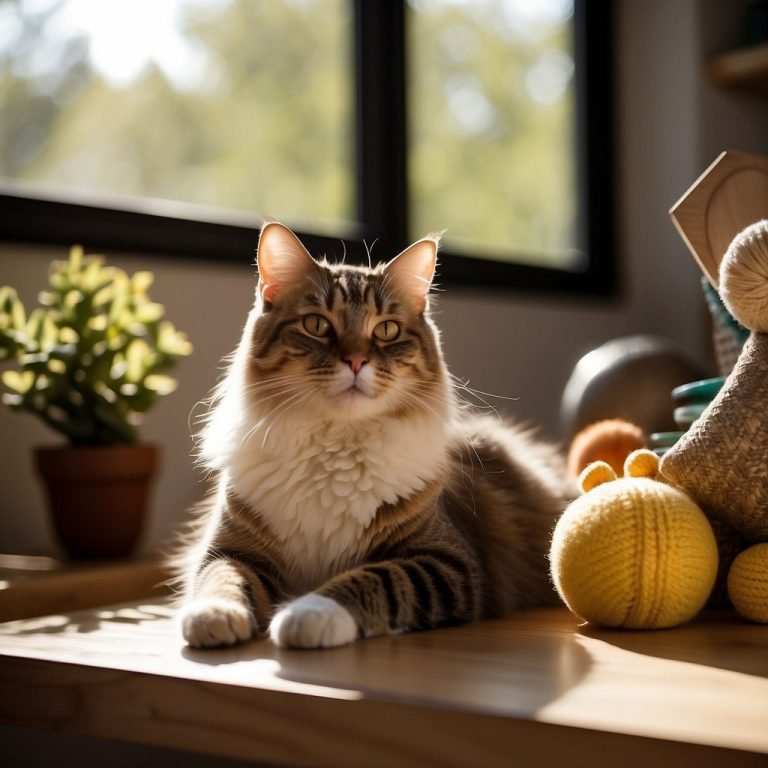Keeping Your Cat in Tip-Top Shape: Purr-fect Health Strategies 🐾

As a cat owner, you know that your furry friend isn’t just a pet, but a member of your family.
Keeping your 🐱 in shape isn’t only about aesthetic appeal; it’s a vital aspect of feline health that ensures your kitty leads a happy, agile, and long life.
Like humans, cats require physical activity to maintain their health, so it’s important to engage them in playful activities that promote a fit and active lifestyle.

Your cat’s health is closely linked to their level of activity and the kind of nutrition they receive.
Whether you have an adventurous outdoor explorer or a snugly housecat, there are plenty of ways to encourage exercise and prevent the risk of health issues such as obesity, diabetes, and arthritis.
A combination of exercise and proper diet is key to any cat’s physical well-being.
Understanding how to stimulate both the body and mind of your feline companion can be a delightful journey for both of you.
It’s not just about keeping fit; it’s also about strengthening the bond you share.
From interactive toys to innovative gadgets like kitty wheels and treadmills, there are numerous options to keep your feline feeling spry and spirited.
Optimal Nutrition for Health
Feeding your cat the right food is vital to keeping them purring and playful.
Below we’ll take a dive into diets that promote health, tackle tummy troubles, and prevent those pesky hairballs.
Understanding Cat Diets
Cats are obligate carnivores, meaning they need a diet high in protein to thrive.
Your feline’s diet should be meat-centric with taurine, an essential amino acid found in animal-based proteins.
Remember, dry food or kibble might be convenient, but it’s often packed with carbohydrates which may not be best for your kitty’s waistline!
Pro Tip: Look for foods that list a high-quality protein (like chicken or fish) as the first ingredient.
Dealing With Digestive Problems
Is your cat’s digestive health causing concern? Digestive problems can manifest as anything from mild upset to more serious conditions.
For sensitive stomachs, a diet high in fiber and probiotics can help support a healthy gut.
Foods with added prebiotics can also stimulate healthy bacteria growth in the colon.
- Checklist for Digestive Care:
- Protein: Easily digestible sources like chicken or turkey
- Fiber: Moderate levels can help with digestion
- Probiotics: Look for these supplements in their food
Preventing Hairballs Through Diet
Hairballs, while common, are not the most pleasant part of cat ownership.
To keep hairballs to a minimum, your furball’s diet should include plenty of fiber.
This helps hair pass through the digestive tract with ease.
Some cat foods are specially formulated to help manage and prevent hairballs.
- Key Hairball Prevention Pointers:
- Omega-3 and 6 fatty acids: Promote a shiny coat and reduce shedding
- Fiber: Aids in hair passage
- Regular grooming: Complements a hairball-control diet
With the right nutrition, your cat can enjoy a hearty diet that supports their overall health, keeps digestive issues at bay, and reduces the frequency of hairballs. 🐾
Designing a Cat-Friendly Space

Creating an inviting space for your cat not only enriches their life but also helps maintain their physical and mental well-being.
It’s all about integration – meshing their needs with your home’s functionality.
Importance of Scratching Posts
Scratching posts are a must-have for any cat-friendly space.
They provide a dedicated area for your cat to maintain their claw health and mark territory — a natural and necessary behavior. Choose scratching posts that are tall enough for your cat to fully stretch and are made of materials like sisal that can withstand lots of feline attention.
The Joy of Cat Trees
😺 Cat trees are like adventure playgrounds for your furry friends! They serve many purposes, providing a place to play, relax, and survey their kingdom from a favored high perch.
Ensure your cat tree is sturdy and offers various levels for climbing, as well as a cozy nook for those much-needed catnaps.
Catio Spaces: Safe Outdoor Experiences
A catio — a patio for your cat — is the perfect compromise to give your kitty a breath of fresh air while keeping them safe.
These enclosed outdoor spaces can be as lavish or as simple as you like, decked out with shelves, ramps, and plants to simulate a natural environment.
Be sure the catio is secure to prevent any clever escapes!
By incorporating these elements, your home will be a feline paradise, and you’ll be rewarded with a happy and healthy kitty. 🐾
Daily Care and Grooming
Maintaining your cat’s grooming routine is pivotal for their well-being.
Specifically, you’ll want to focus on bathing, brushing, and nail care to keep your feline friend purring with pleasure. 🐱
The Basics of Cat Bathing
Bathing your cat may not be needed frequently, but it’s essential when they get particularly dirty or have a run-in with something sticky.
Start by filling a sink or basin with just enough warm water to rinse your cat.
Always use a cat-specific shampoo, lathering gently and avoiding the face.
Rinse thoroughly, and you’ll have a sparkling clean kitty in no time!
Brushing: Managing Loose Hair and Dirt
Regular brushing is crucial for removing loose hair and dirt, and it’s great for bonding with your cat.
The type of brush you use will depend on your cat’s coat.
For short-haired cats, a fine-toothed comb or rubber grooming mitt can do the trick.
Long-haired cats might require a wider-toothed comb and a softer bristle brush.
Aim to brush gently on a daily basis to maintain a sleek coat and minimize hairballs.
Nail Care to Avoid Ingrown Nails
Keeping your cat’s nails trimmed is a key part of preventing ingrown nails.
About every two weeks, take a peek at their paws.
If the nails extend well beyond their pads, it’s time for a trim.
Use a pair of cat nail clippers, and cut only the white tip to avoid the pink quick, which can cause bleeding and discomfort.
If you’re unsure, your vet can demonstrate the purr-fect technique.
Enhancing Your Cat’s Physical Activity
Keeping your cat active is crucial for their overall health and happiness.
Through a combination of play and exercise, you can ensure your furry friend stays agile and mentally stimulated.
Let’s explore some purr-fect ways to get your cat moving!
Playtime and Exercise: Essentials for Health
🐾 Regular Playtime: Ensure you schedule daily play sessions with your cat.
Cats love routine, and setting aside time each day for play can greatly benefit their physical and emotional well-being.
Use various toys that mimic prey-like movements to encourage their natural hunting instincts.
- Laser pointers: A small dot to chase can work wonders.
It mimics the unpredictable movements of prey, giving your cat a burst of energy as they pounce and leap.
- Feather wands: Mimicking birds, feather wands can get your cat jumping and swatting.
Interactive Toys for Mental and Physical Health
🐾 Stimulating Toys: Interactive toys are fantastic for keeping your cat’s mind sharp and their body in motion.
Providing a range of toys that stimulate both their natural instincts and provide a physical workout is key.
- Puzzle feeders: These toys challenge your cat mentally, making them work for their treats. Here are 12 Ways To Help Your Cat Exercise More with a range of interactive gadgets.
- Motion-activated toys: Toys that move on their own can entice even the laziest of cats into an enthusiastic play session.
Remember, a mix of both playtime and interactive toys can help maintain your cat’s mental health, preventing boredom and associated destructive behaviors.
Keep it fun, keep it varied, and watch your cat thrive! 🐱💪
Health Management and Maintenance
Caring for your feline friend involves more than just cuddles and playtime; it’s about keeping them purr-fectly healthy with proactive measures.
Regular veterinary visits, spotting early signs of issues, and keeping that litter box spotless are all part of the plan.
Regular Health Check-Ups
Regular check-ups with your vet are essential in maintaining your cat’s health.
These visits can catch potential health issues early and keep vaccinations up to date.
Typically, an annual vet visit is recommended; however, senior cats or those with existing health conditions may require more frequent appointments.
Pay attention to any changes in behavior or appetite between visits, as these can be indicators that health issues may be present.
Understanding Common Health Issues
Be aware of common health issues like dental disease, obesity, and urinary tract infections.
Cats are adept at hiding discomfort, so understanding symptoms like changes in eating habits, weight, or litter box usage can point to underlying problems.
For instance, if you notice a decrease in grooming or an increase in hiding, it’s time for a trip to the vet.
Litter Box Maintenance and Odor Control
Your cat’s litter box isn’t just part of their daily routine; it’s a barometer for their health.
Ensure the box is always clean, as a dirty litter box can lead to health issues, such as urinary infections. Odor control is also vital, so use clumping litter and scoop daily.
Consider using liners for easier maintenance or placing a mat under the box to prevent litter tracking.
By staying vigilant with these health management tips, you can keep your kitty cat 🐱 in tip-top shape and ready for their next adventure – or nap!

